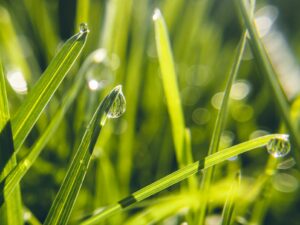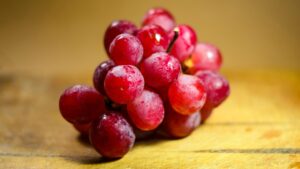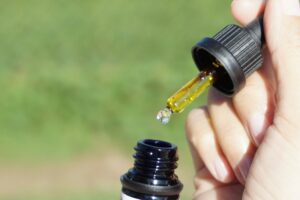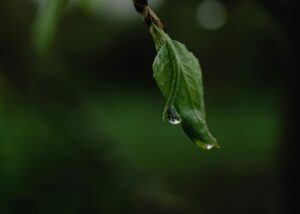Introduction
Honeybee products include honey, bee-collected pollen, royal jelly, wax, and health supplements.
Honey and wax go beyond the food market and are used in large quantities in the manufacture of beauty products, candles, lipstick, medicine, herbal tea and chewing gum. Honey is a natural anti-oxidant and can, for example, be used to extend the shelf life of meat. Other products that can be exploited are pollen, an extremely pure form of protein, propolis (a natural antiseptic), royal jelly (a health and cosmetic product) and bee venom (used medically in the desensitising of allergic people).
Many beekeepers sell their products in bulk to honey packers, or they market their products themselves. Smaller operators often sell from the home, in roadside stalls or to local cafés. The large bee farmers only farm with bees. The smaller ones usually diversify. Beekeeping does not always work on economies of scale (don’t think that a beekeeping operation will only be profitable if you have numerous hives).
Bees are the most important pollinators of agricultural crops, being responsible for about one in every three mouthfuls of food we eat each day.
Source: Mike Allsopp, Dr Connal Eardley (ARC-PHP)
International business environment
There is a worldwide demand for honey and wax.
- The major exporters of honey are China, Argentina, New Zealand, Germany and Mexico.
- The major importers are the USA, Germany, UK, France and Japan.
Most countries have strict regulations regarding the importation of honeybee products and these should be obtained from the local trade commissions. Europe, the USA and Canada require further tests against residues of pesticides in honey.
The supply and demand, foreign exchange rates, and quality of the product all play important roles in determining the world trade prices of all honeybee products.
Some international references:
- APIMONDIA is the International Federation of Beekeepers’ Associations, www.apimondia.org
- Visit the International Bee Research Association pages at https://ibra.org.uk
- International Commission on Plant Pollinator Relations (ICPPR) www.icppr.com
- ApiTrade Africa Expo and The African Honey Magazine, www.apitradeafrica.org
- The British Beekeepers’ Association – www.bbka.org.uk
- Find photographs and a 14 step guide to help bees in the article “What can we all do to help bees?“.
- www.friendsofthebees.org – “bee conservation and natural beekeeping”
- www.beesabroad.org.uk – Bees Abroad is a UK-registered charity which support beekeeping projects in developing countries.
- www.dave-cushman.net, a comprehensive beekeeping website
- Hives Save Lives Africa, an initiative to combat poverty – www.hivessavelives.com
- www.beeculture.com, “The magazine of American Beekeeping”
- The American Apitherapy Society, https://apitherapy.org
- Read about the Pollinator Partnership at https://pollinator.org
- Bees for Development, www.beesfordevelopment.org
- www.malaikahoney.com, the website of Malaika Honey (Uganda)
- Find the literature on bees at http://bees.library.cornell.edu.
- Wikifarmer Editorial Team. 2017. “Beekeeping for beginners”. Available at https://wikifarmer.com/beekeeping-for-beginners/
- Find Value-added products from beekeeping on the Food and Agriculture Organisation (FAO) of the United Nations website, www.fao.org. This volume is intended to improve the possibilities for diversification in beekeeping activities.
- Find The Ultimate Guide to British Bees: How to Protect Their Declining Population by Clive Harris. The article asks and answers the many questions you may have about bees like what do they eat, the difference between bees and wasps, how they make honey and beeswax etc. It lists the ways in which we can help bees. See also https://diygardening.co.uk/help-bee-population
South Africa imports and exports
- In 2024 South Africa exported honey to the value of R45 million. The main destinations were neighbours – Botswana, Namibia, Eswatini, Lesotho and Mozambique (OEC, 2025).
- South Africa imported R104 million worth of honey. The origins of this honey were China, Zambia, India, Poland and Yemen (OEC, 2025).
Local business environment
The latest chairperson’s report on www.sabio.org.za provides a good overview of what is happening locally.
- In South Africa, honeybees pollinate over 50 agricultural crops, essential for food and job security, and worth over R10.3 billion per annum to our economy (Dugmore, 2024).
- Problems affecting bees include insufficient forage, theft and vandalism, disease, environmental hazards such as pollution and exposure to external factors such as fires and drought. The notes at www.sabio.org.za/honeybees-of-south-africa set out information on South African honeybee subspecies; bee diseases, pests and parasites; and pesticides.
- South Africa produces around 2 000 tonnes of honey per year, and consumes approximately 5 000 tonnes (Nkunjana & Radebe, 2024).
- There are regulations regarding importation of beeswax and honey in order to keep infectious diseases out of the country. All imported honey and bee products need to be irradiated for disease control purposes, and are required to display the radurised sign on these products.
- Issues of concern include food fraud (imported honey that is a fake honey using sugar and other ingredients) and honey labelling. In the latter case, the vagueness of country of origin (two or more countries are listed) (Sihlobo, 2018). This suggests a lack of compliance with any legal requirements.
Further reference:
- Find the “Honey Fraud” option at www.sabio.org.za.
- Dugmore H. 2024, November 15. “The critical role honeybees play in SA’s agricultural economy and biodiversity.” Daily Maverick. Available at www.dailymaverick.co.za/article/2024-11-15-the-critical-role-honeybees-play-in-sas-agricultural-economy-and-biodiversity
- Nkunjana T & Radebe N. 2024, March. “A High-Level Analysis of the South African Natural Honey Sector”. TradeProbe 96. Available at www.namc.co.za/wp-content/uploads/2024/04/Trade-Probe_Issue-96-2.pdf
- Botha L. 2022, October 11. “The approaching crisis threatening SA’s bees and beekeepers”. Farmer’s Weekly. Available at www.farmersweekly.co.za/agri-technology/farming-for-tomorrow/the-approaching-crisis-threatening-sas-bees-and-beekeepers/
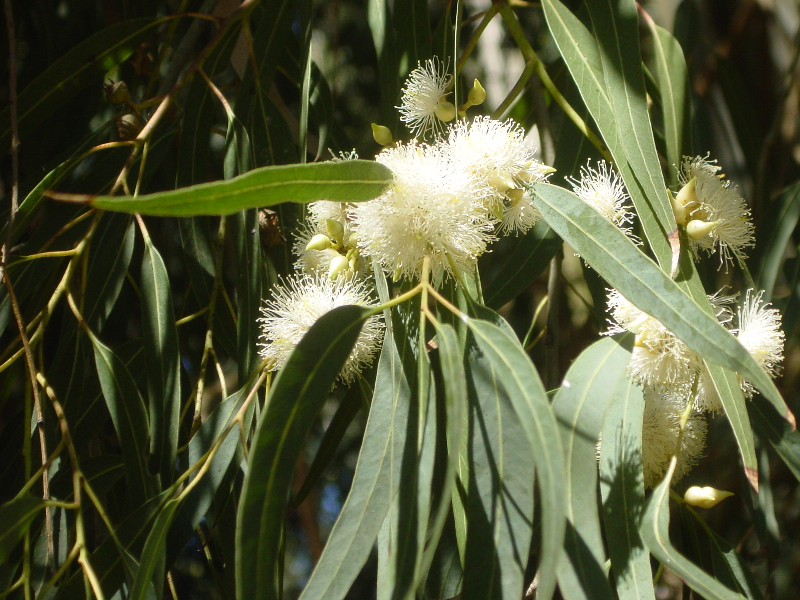
Eucalyptus flowers. Photo used courtesy of Mike Allsopp (ARC) and SANBI |
Find the notes on different diseases (including AFB) under the “Honeybees of South Africa” option at www.sabio.org.za.
For the newcomer
Apiculture (bee-farming) is ideal for women, young people and the disabled, people who also have other responsibilities such as housework, school or are physically challenged. When husbands migrate to cities to seek employment, women stay behind with all the responsibilities. Beekeeping offers an opportunity to earn an income while tending to the rest of her agricultural and household responsibilities. It is light labour and not mechanised. It is not suitable for the lazy though.
When honeybees have been established in beehives, the bees will produce the honey and other hive products. The farmers’ job is to pay attention to their bees and manage their hives effectively. Bees are a free workforce that will work for the farmers as long as there are nectar-producing plants in the area.
Honeybees are found all over South Africa and are a free and accessible resource. People do not have to own land but only need permission to place their hives in a safe place. If there are adequate bee plants in an area to allow bees to produce surplus nectar a beekeeping operation could be started.
The success of these sort of programmes depend on the South African honey consumer market knowing about them, and on the beekeepers’ abilities to exploit the spin-offs from hive products.
Tips for Newcomers to the Beekeeping Industry
- Bee colonies have to be protected from the wind. If no natural windbreak is available, erect a temporary wind shelter.
- Colonies should be placed in sunny locations and preferably where the sun shines on the entrances.
- Hives should be kept off the ground with old tyres or concrete blocks as dampness and the lack of ventilation could stress the bees.
- Ensure uncontaminated water is close to the hive.
Source: Brett Falconer, Highveld Honey Farms
Honeybees are also of value in South Africa as vehicles of Empowerment and Rural Development. Small-scale beekeeping has great potential as a means of entrepreneurial development and economic empowerment, particularly among rural communities and especially for women. Collaboration and partnerships between companies like SAPPI and MONDI, government and local communities result in economic development for a large number of communities and individuals in South Africa.
Read about the Beekeeping for Poverty Relief Programme (BPRP) on the ARC website, www.arc.agric.za.
Honeybee forage plants: what you can do to help
The reduction of bee forage sources in the country, caused by, among other things, urban development and overpopulation, was identified in the Western Cape honeybee strategy (2018) as the single largest threat to bees.
A study undertaken by the South African National Biodiversity Institute (SANBI) revealed that gum trees, certain crops, indigenous trees and shrubs, flowering plants in suburban gardens and even roadside wildflowers or weeds are all critically important to South Africa’s indigenous honeybees. Forage availability and accessibility for honey bees are a large constraint to beekeepers in South Africa. A lack of good quality and variety of forage can lead to unhealthy honey bee colonies that are more vulnerable to pests and diseases. This, in turn, can lead to insufficient pollination of our important agricultural crops. A major factor in the decline of honeybees around the world is a lack of good forage plants that provide the nectar (carbohydrates) and pollen (protein) sources that bees require for their nutritional health.
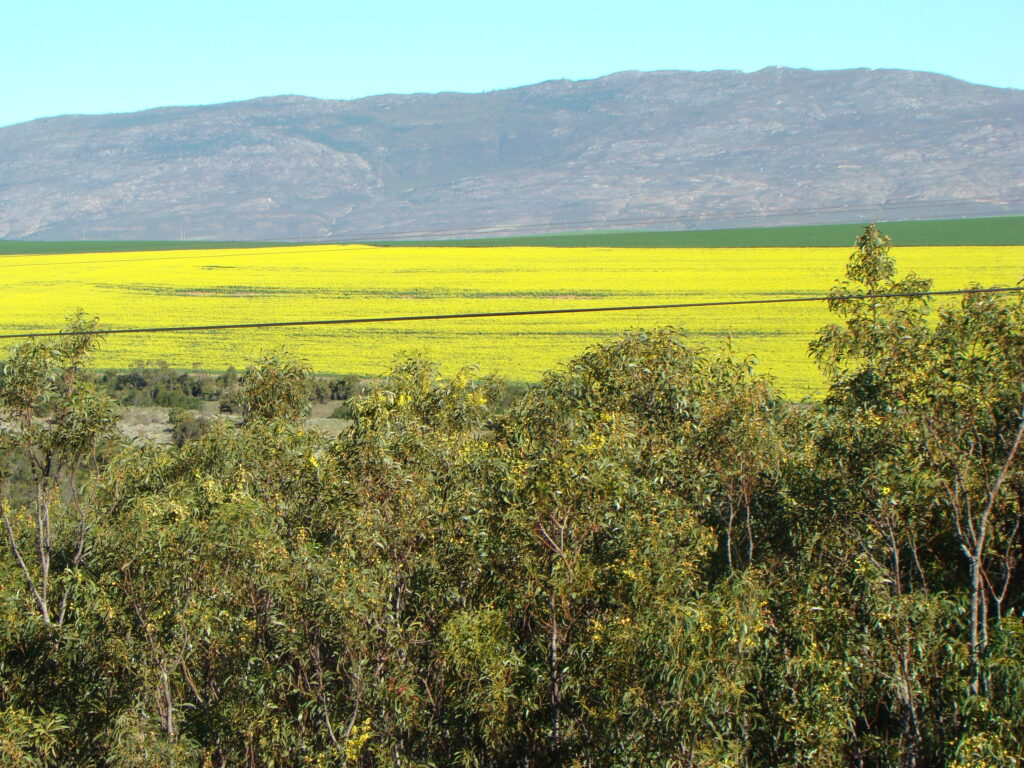
| Landscape showing bee forage: eucalyptus and canola. Photo used courtesy of Tlou Masehela and SANBI. |
You can help in any of the following ways:
- Allow beekeepers access to utilise the forage resources on your land, and work with the beekeepers to make sure hive sites are secure and inaccessible to vandals.
- Protect your natural vegetation through incorporating pollinator habitat or forage concerns into agricultural best practice, land-clearing authorisations (i.e. do not unnecessarily clear virgin land), Environmental Impact Assessment processes, and landuse planning policies and tools.
- Adhere to the Alien and Invasive Species Regulations under the National Environmental Management: Biodiversity Act, 2004 regarding gums (eucalyptus) on your land. Six Eucalyptus spp. are listed as invasive and must be controlled. Other gums may be maintained or planted for bee foraging purposes.
- Consider planting indigenous bee-friendly plants when gardening, planting wind-breaks or when rehabilitating after a development (e.g. dam walls, road berms, etc.) Be sure to plant plants that are appropriate to your specific area. Check with your local nursery for subspecies or varieties that occur locally to avoid invasive problems or hybridisations with veld species in the vicinity.
- Honey bees will visit any flowering crop (especially the very attractive ones like canola, lucerne, sunflowers, citrus) as well as other flowers and weeds. Please take this into account when spraying chemicals – consult the label and adhere to its instructions. Be careful of chemicals when gardening too.
- Encourage public land planting programmes (e.g. under power lines, along road verges, or urban greening programmes) to consider bee-friendly plant species first.
- Consider planting complementary crop plants (such as lavender or basil) or fodder crops (like clovers or vetch), or rotate land with legumes crops, as these are all important honey bee forage.
- Do not unnecessarily spray or remove weeds that are attractive to bees (e.g. wild radish, cosmos, etc.)
Lists of bee-friendly plants are available on www.sanbi.org (search “bee-friendly”). Also find the reference to the publication Beeplants of South Africa under heading 10. For more information, please contact Mbulelo Mswazi on m.mswazi [at] sanbi.org.za.
National strategy and government contact
The legislation option at www.sabio.org.za gives notes on the following with brief implications for the beekeeper:
- Agricultural Pests Act (36/1983), including Control Measure GN R858 15 November 2013 – Control Measure relating to Honeybees. Amongst other things, all beekeepers must register with DALRRD on an annual basis. Find the form on the SABIO website.
- Agricultural Product Standards Act (Act 119 of 1990)
- Foodstuffs, Cosmetics and Disinfectants Act (Act 54 of 1972), including Regulation R146
- Health Act, 1977 (Act 63 of 1977), specifically Government Notice R918 of 1999
- Conservation of Agricultural Resources Act, 1983 (Act 43 of 1983) (CARA)
- National Environmental Management of Biodiversity Act, 2004 (Act No 10 of 2004), (NEMBA)
- Some municipal by-laws (depending on where you live)
Legislation divides South Africa into a Cape beekeeping region and a Scutellata (African Honeybee) beekeeping region, along the “Siegfried Line”, an estimate of the traditional boundary between the races. Honeybees are not allowed to be moved across the line in either direction except under permit issued by the Department of Agriculture.
Find information and contact details of the different directorates of Department of Agriculture at www.nda.gov.za.
Bees, in general, are very sensitive to disturbance of their habitat, and some land use changes lead directly to their local extinctions. Thus bee biodiversity conservation has become a global concern. Taxonomy is essential for proper bee conservation and management.
Contact: Dr Connal Eardley. E-mail: eardleyc [at] arc.agric.za
Role players
View the Premium Listings below (scroll down or click on “Premium Listings” on the Table of Contents to the right).
Further reference:
Associations and NPOs
- The South African Bee Industry Organisation (SABIO) represents all aspects of the honeybee industry in South Africa, its role also catering for the interests of bottlers and packers of honey and bee products as well as to the manufacturers of bee equipment. It is involved with training of future beekeepers and the implementation of guidelines for food safety and correct packaging of honey. SABIO also ensures that a quarterly bee journal is published, and organises the annual Bee Congress.
Training and research
- The Agricultural Colleges, working with Provincial Departments of Agriculture run courses in beekeeping. See the “Agricultural education and training” page. Further research and beekeeping training course providers are listed above.
Websites and publications
Visit websites listed elsewhere on this page e.g. www.sabio.org.za, www.beekeepers.co.za, http://wkbv.co.za etc.
The South African Bee Journal (SABJ) is a quarterly periodical published by SABIO. Find details on the SABIO website.
Hortgro‘s Fresh Quarterly Issue 25 June 2024 is all about honeybees. Find it at www.freshquarterly.co.za/publication/fresh-quarterly-issue-25-jun-2024/
Find the Green Trust video “Save the bees! Plant indigenous, bee friendly forage today!” on YouTube.
Johannsmeier, M.F. 2016. Beeplants of South Africa. Pretoria: South African National Biodiversity Institute (SANBI). To order the book contact bookshop [at] sanbi.org or call 012 843 5000. Find other SANBI material at www.sanbi.org.
Johannsmeier, M.F. (Ed). 2001. Beekeeping in South Africa. 3rd edition. Pretoria: Agricultural Research Council. The “Blue Book” provides information and instruction, caters for hobbyists, beginners and professionals. Call 021 887 4690, email allsoppm [at] arc.agric.za or visit www.arc.agric.za.
Find the WWF SA “Gums, honey bees & biodiversity” download at www.wwf.org.za/our_research/publications
Donald, D., Trull, S., Marchand, D., Jacobs, V., Marchand-Mayne, J. & Merrington, M. 2009. The Bee Book – A Guide to Top-Bar Beekeeping in Southern Africa. Cape Town: Juta. This accessibly written and beautifully illustrated practical guide has four main purposes, to provide:
- a text book for adult learning and training in Agriculture in the FET college and ABET contexts
- a practical field guide to top-bar beekeeping for teachers, who are setting up a beekeeping project involving their learners/students in schools and colleges
- a training and development handbook for agricultural extension officers
- a practical guide and reference for communities starting income-generating entrepreneurial ventures
Marchand, D. & Marchand-Mayne, J. 2003. Beekeeping – a practical guide for Southern Africa. Onrus River: Aardvark Press. See www.aardvarkpress.co.za.
Bee Ware supplies a DVD, Practical Beginner Beekeeping training and various beekeeping publications. Visit www.beeware.co.za for details.
Find the two Department of Agriculture Info Paks on bees at www.nda.gov.za. The first is “Basic Beekeeping”. The second is entitled “Bee: Capensis bee problem”.
Kejafa Knowledge Works has publications on beekeeping. Visit www.kejafa.com for the following:
- Byeboerdery in Suid Afrika Anderson, Buys, Johannsmeier ISBN: 978-0-6204447-7
- Storey’s Guide to Keeping Honey Bees Sanford, Bonney ISBN: 978-1-60342-550-6
Call 012 842 4017 or send an email to stoltze [at] arc.agric.za for the following publication, available from the ARC Agricultural Engineering: Agro-processing of honey products.
Find the publications, some available as a free download, at www.biobees.com.
Find the cartoon commissioned by the Public Understanding of Biotechnology (PUB) on iQhilika at www.pub.ac.za/cartoons/.
Wilson, B. 2005. The Hive: The Story of the Honeybee and Us. London: John Murray.
Marchese, C.M. 2009. Honeybee: Lessons from an Accidental Beekeeper. New York: Black Dog & Leventhal.
Eardley, C., Roth, D., Clarke, J., Buchanan, S. & Genmill, B. 2006. Pollinators and pollination: a resource book for policy and practice. Pretoria: Agricultural Research Council (ARC).
Watch the YouTube video “Beekeeping How To Start Beekeeping In 2021”.
Forage zone overlay for google maps:
Use this tool to plot your apiary locations and discovery your honeybees potential foraging zones.
Honey Bee Rescue & Removal
The URL is advertised in a number of magazines and allows end users to request a honey bee removal. The removal is automatically entered into the Apiculture SA honey bee rescue incident system, attended to by beekeepers within SA.
Some articles
- Reporter. 2024, December 22. “From top corporate executive to beekeeper”. Daily Investor. Available at https://dailyinvestor.com/south-africa/72154/from-top-corporate-executive-to-beekeeper/
- Price I. 2024, November 15. “Bees vital to SA crops amid growing forage shortages”. Food for Mzansi. Available at www.foodformzansi.co.za/bees-vital-to-sa-crops-amid-growing-forage-shortages/
- Kyra. 2024, April 25. “Western Cape Bee Industry Association Sets New Guideline Tariff for Pollination Services”. HORTGRO. Available at www.hortgro.co.za/news/western-cape-bee-industry-association-sets-new-guideline-tariff-for-pollination-services/
- Steenkamp EM. 2024, March 26. “Challenges ahead for “celebrity” Cape honeybee”. HORTGRO. Available at www.hortgro.co.za/news/challenges-ahead-for-celebrity-cape-honeybee/
- Steyn T. 2022, August 31. “Beekeeping part 1: Introduction to beekeeping”. Proagrimedia. Available at www.proagrimedia.com/livestock/beekeeping-part-1-introduction-to-beekeeping/
- Selig S. 2021, December 6. “Record spike in pollination demand puts honeybees in danger”. IOL. Available at www.iol.co.za/business-report/economy/record-spike-in-pollination-demand-puts-honeybees-in-danger-8959fad0-2162-44d3-965b-00284b7dd1c6
- Selig S. 2021, October 22. “Analysis: SA’s beekeeping is up 400%, but is it still poised to fail?” IOL. Available at www.iol.co.za/business-report/economy/analysis-sas-beekeeping-is-up-400-but-is-it-still-poised-to-fail-703089cb-524b-4d7d-8e4b-eadc68588cc9
- Masehela T. 2021, August 30. “What honeybees in South Africa need from people: better managed forage”. The Conversation. Available at https://theconversation.com/what-honeybees-in-south-africa-need-from-people-better-managed-forage-166369
- Luckhoff P. 2021, June 23. “Beware the trap of ‘honey laundering’ and support local beekeepers”. 702. Available at www.702.co.za/articles/420010/beware-the-trap-of-honey-laundering-and-support-local-beekeepers
- Crouth G. 2021, May 23. “Don’t bee fooled: Consumers and retailers warned of honey fraud”. Daily Maverick. Available at www.dailymaverick.co.za/article/2021-05-23-dont-bee-fooled-consumers-and-retailers-warned-of-honey-fraud
- Raats J. 2020, July 17. “Byeboer hou bye veilig met betonkorwe” [beekeeper keeps hives safe with concrete baskets]. Landbouweekblad. Available at www.netwerk24.com/landbou/Boereplanne/byeboer-hou-bye-veilig-met-betonkorwe-20200713
- Botha L. 2020, July 8. “Making agriculture more bee-friendly”. Farmer’s Weekly. Available at www.farmersweekly.co.za/agri-technology/farming-for-tomorrow/making-agriculture-more-bee-friendly/
- Kitchen K. 2020, February 3. “Just a spoonful of sugar? – Is your honey pure?” Go Legal. Available at www.golegal.co.za/sugar-honey-products/
- Sihlobo, W. 2018, August 20. “Honey caught my eye again today”. Available at https://wandilesihlobo.com/2018/08/20/honey-caught-my-eye-again-today/
- Sihlobo, W. 2018, June 27. “The Great South African Honey Puzzle”. Available at https://wandilesihlobo.com/2018/06/27/the-great-south-african-honey-puzzle
- Find the blog “Eucalypts and other honey bee forage plants – what you can do to help our honey bees” on www.agrihandbook.co.za.
Some international articles
- Jaynes CH. 2025, May 20. “Experts Identify Emerging Threats to Bees, From Wars to Microplastics and Light Pollution.” EcoWatch. Available at www.ecowatch.com/bees-emerging-threats.html
- Jaynes CH. 2025, March 25. “U.S. Honeybee Deaths Reach Record High: Survey”. EcoWatch. Available at www.ecowatch.com/honeybees-deaths-us-2025.html
- Duran AE & Ünveren B. 2025, February 16. “Turkish fake honey production on the rise”. DW. Available at www.dw.com/en/turkish-fake-honey-on-the-rise/a-71626685
- Dorey JB, Gilpin AM & Gloag R. 2024, April 24. “Most bees don’t die after stinging – and other surprising bee facts”. The Conversation. Available at https://theconversation.com/most-bees-dont-die-after-stinging-and-other-surprising-bee-facts-227162
- White SJ & Wilson PB. 2024, March 27. “Honey is said to help with hay fever symptoms – here’s what the research says about this claim”. The Conversation. Available at https://theconversation.com/honey-is-said-to-help-with-hay-fever-symptoms-heres-what-the-research-says-about-this-claim-225728
- Durant J. 2022, October13. “Bees face many challenges – and climate change is ratcheting up the pressure”. The Conversation. Available at https://theconversation.com/bees-face-many-challenges-and-climate-change-is-ratcheting-up-the-pressure-190296
Sources for the page: South African Bee-Industry Organisation (SABIO); Mike Allsopp (ARC-PHP); Dr Connal Eardley (ARC-PHP; Brett Falconer (Highveld Honey); South African National Biodiversity Institute


